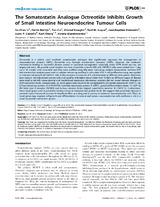Mostrar el registro sencillo del ítem
The Somatostatin Analogue Octreotide Inhibits Growth of Small Intestine Neuroendocrine Tumour Cells
| dc.contributor.author | Li, Su-Chen | |
| dc.contributor.author | Martijn, Cécile | |
| dc.contributor.author | Cui, Tao | |
| dc.contributor.author | Essaghir, Ahmed | |
| dc.contributor.author | Luque, Raúl M. | |
| dc.contributor.author | Demoulin, Jean-Baptiste | |
| dc.contributor.author | Castaño, Justo P. | |
| dc.contributor.author | Öberg, Kjell | |
| dc.contributor.author | Giandomenico, Valeria | |
| dc.date.accessioned | 2013-04-09T11:58:33Z | |
| dc.date.available | 2013-04-09T11:58:33Z | |
| dc.date.issued | 2012 | |
| dc.identifier.uri | http://hdl.handle.net/10396/9642 | |
| dc.description.abstract | Octreotide is a widely used synthetic somatostatin analogue that significantly improves the management of neuroendocrine tumours (NETs). Octreotide acts through somatostatin receptors (SSTRs). However, the molecular mechanisms leading to successful disease control or symptom management, especially when SSTRs levels are low, are largely unknown. We provide novel insights into how octreotide controls NET cells. CNDT2.5 cells were treated from 1 day up to 16 months with octreotide and then were profiled using Affymetrix microarray analysis. Quantitative real-time PCR and western blot analyses were used to validate microarray profiling in silico data. WST-1 cell proliferation assay was applied to evaluate cell growth of CNDT2.5 cells in the presence or absence of 1 mM octreotide at different time points. Moreover, laser capture microdissected tumour cells and paraffin embedded tissue slides from SI-NETs at different stages of disease were used to identify transcriptional and translational expression. Microarrays analyses did not reveal relevant changes in SSTR expression levels. Unexpectedly, six novel genes were found to be upregulated by octreotide: annexin A1 (ANXA1), rho GTPase-activating protein 18 (ARHGAP18), epithelial membrane protein 1 (EMP1), growth/differentiation factor 15 (GDF15), TGF-beta type II receptor (TGFBR2) and tumour necrosis factor (ligand) superfamily member 15 (TNFSF15). Furthermore, these novel genes were expressed in tumour tissues at transcript and protein levels. We suggest that octreotide may use a potential novel framework to exert its beneficial effect as a drug and to convey its action on neuroendocrine cells. Thus, six novel genes may regulate cell growth and differentiation in normal and tumour neuroendocrine cells and have a role in a novel octreotide mechanism system. | es_ES |
| dc.format.mimetype | application/pdf | es_ES |
| dc.language.iso | eng | es_ES |
| dc.publisher | Public Library Of Science (PLOS) | es_ES |
| dc.rights | https://creativecommons.org/licenses/by/4.0/ | es_ES |
| dc.source | PLoS ONE 7(10), 112 (2012) | es_ES |
| dc.subject | Endocrinology | es_ES |
| dc.subject | Somatostatin | es_ES |
| dc.subject | Tumour cells | es_ES |
| dc.title | The Somatostatin Analogue Octreotide Inhibits Growth of Small Intestine Neuroendocrine Tumour Cells | es_ES |
| dc.type | info:eu-repo/semantics/article | es_ES |
| dc.rights.accessRights | info:eu-repo/semantics/openAccess | es_ES |

